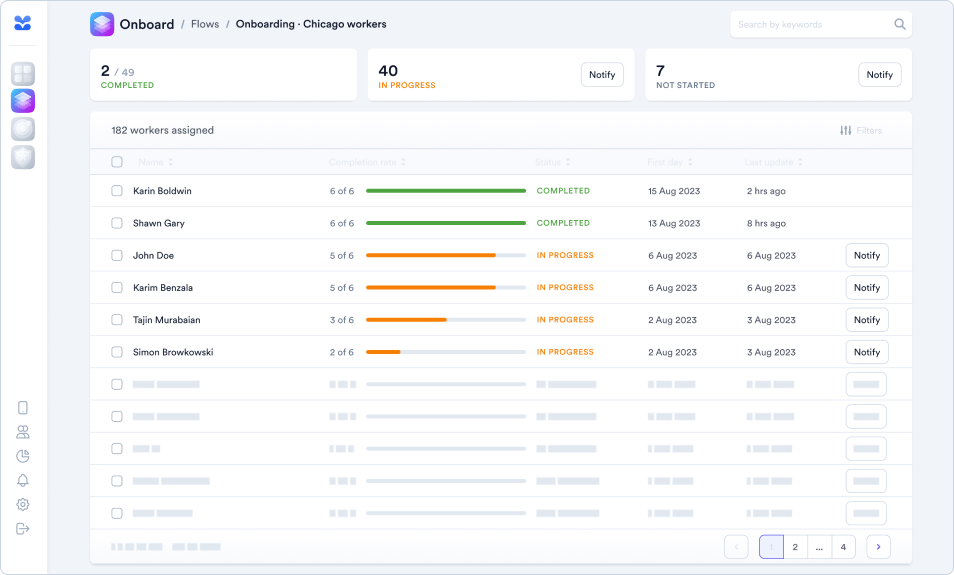Once you’ve hired an hourly worker, you may think your job is done. But the truth is, your job (and your new hire’s journey to employment) has only just begun. For example, did you know it can take as long as five months for a new hire to be fully productive?
So what’s standing in the way of new hires getting up to speed? It’s usually a sluggish onboarding process.
When you’re armed with a foolproof onboarding plan, you’re able to fast-track workers to their first day, while also increasing the chances of worker longevity. Plus, you’ll reap a higher return on investment from your hiring process.
In this post, we’re sharing with you a comprehensive employee onboarding checklist to help you cover the essentials as you prepare new hires for their first day on the job.

What is an employee onboarding checklist?
Onboarding new hires is one of the most important, yet often overlooked, steps of the entire recruitment process. Onboarding can set the tone for a new hire’s experience at their new job and can have a direct impact on how satisfied they are and therefore how long they choose to stay at the job. For hourly workers, turnover tends to be high, so providing an exceptional onboarding experience is of the utmost importance.
To onboard efficiently and ensure you complete each step with care, we’ve created an employee onboarding checklist to help align your actions with your onboarding strategy. This checklist also helps round out the entire employee lifecycle within your organization.
The ultimate employee onboarding checklist
This checklist covers the following stages in the onboarding process:
- Pre-hire
- First day
- First week
- First quarter
- Second quarter
Pre-hire onboarding checklist
The pre-hire stage of onboarding starts once new workers are actually hired but before their official start date. During this critical period of time—a period during which many recruiters see new hires drop out or choose not to show up for their first day—it’s important to engage your new hires and make sure they have everything they need before their first day, including the following.
Paperwork and documentation
If the following documents weren’t collected during the application stage, you’ll need to prepare the essential paperwork that new hires will need to review and sign, including:
- I-9 form for Employment Eligibility Verification
- W-4 form so you can collect federal income tax
- Direct deposit forms
- Non-disclosure agreements
- Insurance forms
Learn more about how Fountain Compliance can help keep you on track.
You’ll also need to arrange the following, if applicable:
- Add new hires to the company email list.
- Include new hires in relevant forums and chat groups.
- Provide an ID card and/or access key(s)/fob(s).
- Arrange parking or transportation to work.
Welcome communications
Before your new hires start their new role, send an email or text message to them to reiterate your enthusiasm and provide them with all the crucial info they’ll need for their first day. Your welcome message could look something like this:
- A few sentences to welcome them to the team and express how grateful you are to have them joining your company
- Start date, time, and location
- A tentative schedule for their first day
- Important documents they’ll need to bring
- Any notes about the dress code/uniform
- Who they’ll be meeting with on their first day
- A PDF or link to your employee handbook
- Any necessary reading material to help them prepare for their duties
In addition to this message, you also may want to send a separate message to your existing workers to let them know new members will be joining their team. This message could include:
- The new hires’ names, job titles, and designated teams
- The new hires’ start dates, times, and locations
- Existing employees’ roles in helping the new hires get settled
First-day employee onboarding checklist
On their first day of work, your new hires may be anxious, so it’s your job to prepare them as much as possible with a clear first-day onboarding checklist. Keep reading for examples of what these checklists might look like.
Workplace orientation
- Arrange for an employee to meet new hires at a designated onsite location.
- Schedule a morning coffee to welcome your new hires.
- Give the new hires a tour of their new workplace.
- Assist your new hires in setting up their equipment, if applicable.
- Give your new hires instructions on how to use equipment they’ll need to use to perform their job functions.
Legal documentation and paperwork
Once your new hires get acquainted with their new workspace, it’s time to knock out the paperwork that wasn’t a part of the application or pre-hire stages.
- Explain your new hires’ benefits package, such as stipends, insurance, time-off policy, etc.
- Show them where Human Resources policies and procedures are kept.
- Review safety and security procedures.
- Explain the code of conduct.
- Review and complete any necessary forms and contracts
Meet with management
The new hires’ manager(s) can review in more detail their role and daily activities. The following are examples of topics the manager should cover with their new hires:
- The company’s vision, mission, and values
- The company’s organizational chart and where the new hires live on this chart
- The new hires’ responsibilities; a review of their job duties
- Clear expectations for the new hires’ first month, three months, and six months regarding work output and conduct
- The new hires’ hopes and objectives for their time at the company
- A possible career development plan, which includes the path to promotion and how bonuses are earned
First-week employee onboarding checklist
The first week is just as important as the first day when onboarding new hires.
During the first week, your employee onboarding checklist may see some overlap with first-day duties, but it should look something like this:
- Set up a series of one-to-one meetings to review expectations.
- Organize relevant training sessions.
- Allocate work that will help the new hires better understand their roles/set up a shadow program for the new hire with an existing employee who performs the same tasks
- Invite the new hires to any social events like team lunches.
- Encourage the new hires to ask as many questions as possible!
First-quarter employee onboarding checklist
Onboarding new hires doesn’t end after the first day, week, or month. It can last up to a year!
According to the Society for Human Resource Management (SHRM), 23% of employees left their jobs during the first six months, noting they would have stayed longer if they had received more effective training.
During the first three months, make a point to revisit the new-hire onboarding checklist above and consider adding the following:
- Outline six-month goals, track progress, and give feedback at different checkpoints; set performance goals and objectives.
- Set up ongoing training sessions to keep their skills sharp and offer opportunities for upskilling.
Read more about reskilling and upskilling in the manufacturing industry.
- Encourage team members and other managers to provide constructive feedback to new hires.
- Add informal performance reviews to your new hires’ calendars.
- Ask for feedback from the new hires.
Second-quarter employee onboarding checklist
If your new hires are still with you when you reach their second quarter, congratulations! This is definitely an important milestone in the life of an hourly worker.
But don’t relax just yet. You’ll still need to act on the items on your new-hire checklist to ensure they’re acclimating successfully.
At this stage, the following should be added to your new-hire onboarding checklist:
- Yearly performance review
- Recognition of your new hires’ achievements
- Provision of an unofficial career development plan, considering the new hires’ professional and personal goals
- A six-month performance review
- Objectives and goals for the next six months
Tips to improve your onboarding strategy
Now that you have the checklist to guide you and your new hires through the most important steps of onboarding, how can you ensure your greater onboarding strategy is equally clear and scalable?
Here are a few tips to adapt your onboarding strategy for both your recruiting team and your new workers.
Ready to enter a new era of onboarding? Click here to learn more about Fountain Onboard.
Rethink objectives
The general goal of a successful employee onboarding plan is to make sure new hires are prepared for their new job. While this is still a major focus, companies have found that employee engagement is also a desired outcome of onboarding. How can hiring teams achieve this?
Develop a strategic onboarding plan
Because an onboarding program is such a crucial piece of the hiring puzzle, everyone involved must be on the same page about its deployment. In the same way a strategic plan is necessary for performance reviews, new-hire onboarding also deserves attention because of its far-reaching effects on the business.
Your strategic onboarding plan should include who will be onboarded, the length of the onboarding process, and what steps need to occur.
Learn how to optimize your mobile onboarding process with mobile learning.
Ask for feedback
Once new hires are onboarded, you can issue a quick survey to get their feedback on the process. This can help inform your onboarding strategy going forward.
How a mobile-first platform helps with your onboarding strategy
When it comes to strategic onboarding, especially when hiring a high volume of workers, a modern, mobile-first ATS like Fountain can be your best ally. In one platform, you can keep candidates engaged through automated messaging, allow them to upload their credentials and legal documentation, and even conduct a video interview on demand.
Fountain also integrates with mobile learning platforms like Lessonly and NorthPass, so your new hires can start learning the ins and outs of the job, all from their mobile device.
To find out how Fountain can help you revolutionize your hiring and onboarding processes, click here to request a demo.




